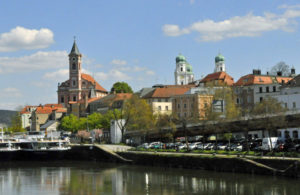
Passau, Germany, from Danube River (Photo by Don Knebel)
From 999 to 1803, Passau was ruled by a prince-bishop, a bishop with secular powers. Veste Oberhaus, the bishop’s imposing fortress, still overlooks the city from a small mountain across the Danube. A large red wolf from the bishop’s coat of arms adorns the building’s exterior. The wolf once identified swords forged in Passau, which were revered because users thought the wolf gave them divine protection
One of Passau’s main attractions today is the St. Stephen’s Cathedral, whose twin towers can be seen throughout the city. The cathedral was erected in the Baroque style between 1668 and 1693 after an earlier cathedral was destroyed in a fire. St. Stephen’s pipe organ has grown over the years until it now has 17,774 pipes and 233 registers. The organ was the largest in the world until 1994, when it was outdone by a church organ in Los Angeles and had to settle for being the largest outside the United States. The sound of this massive organ can be drowned out by eight large bells hanging in the towers’ bell rooms The largest, cast in 1952, weighs more than eight tons.
Passau is sometimes called the City of Three Rivers because it lies at the intersection of the Danube, Inn and Ilz Rivers. About once every five years, one of the rivers floods. In 2013, persistent rains caused the Danube to reach levels several feet above the tops of doors in the city center. The outside wall of an old building marks the crests of 10 major floods since 1501. The 2013 waters reached a level not seen in 500 years.
Comments are closed.